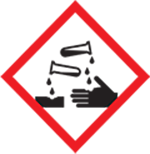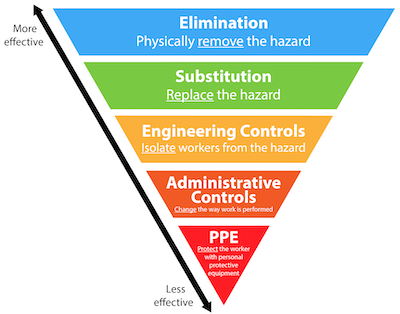Sodium hydroxide
This chemical standard operating procedure (SOP) and the associated Safety Data Sheet (SDS) are for our safety. Read and understand both documents. If this is a paper copy, check for updated versions on the IsoLab website.
Process
Sodium hydroxide is used to lyse bacterial cells as part of our bacterial denitrifier method.
Hazards - SDS

May be corrosive to metals. Causes severe skin burns and eye damage. Harmful to aquatic life.
Protection - SDS

Engineering Controls
A fume hood is not required for sodium hydroxide.
Administrative Controls
No administrative controls are required for sodium hydroxide.
Personal Protective Equipment (PPE)
Wear a laboratory coat, eye protection, and nitrile gloves when working with sodium hydroxide.
Handling - SDS
Keep container tightly closed when not in use.
Storage - SDS
In general, sodium hydroxide must be stored below eye level. Use MyChem, the UW EH&S chemical inventory database, for the most up-to-date information on sodium hydroxide storage. Presently, sodium hydroxide is stored in the corrosives cabinet under the west fume hood of 303B.
Spills - SDS
Exposure:
- Inhalation - If inhaled, move to fresh air. For advice, call UW Employee Health Center (206.685.1026) or the Washington Poison Center (800.222.1222). For emergency help, call 911.
- Skin contact - Remove contaminated clothing. Rinse skin with water / shower. For advice, call UW Employee Health Center (206.685.1026) or the Washington Poison Center (800.222.1222). For emergency help, call 911.
- Eye contact - Rinse with water at an eyewash station. For advice, call UW Employee Health Center (206.685.1026) or the Washington Poison Center (800.222.1222). For emergency help, call 911.
Grab the closest spill kit and make sure you are wearing a lab coat, eye protection, and nitrile gloves. Soak up spilled sodium hydroxide with absorbent material. Place all debris in waste container or bag. See below for waste handling.
If you need assistance or advice, use the IsoLab Emergency Contacts sheet.
Consult the EH&S Spill Poster and Exposure Poster
Waste - SDS
If you are cleaning up after a spill and have a bag of debris, ensure the bag is sealed and use multiple bags as needed. Complete an EH&S Hazardous Waste Label and adhere it to the bag. Here are instructions for how to label chemical waste containers. Labels are located in a drawer on the west wall of 303B near the door to the hallway.
Put all waste, solid or liquid, into a plastic container. Options for waste containers can be found under the west sink in 303B. Complete an EH&S Hazardous Waste Label and adhere it to the bottle. Here are instructions for how to label chemical waste containers. Labels are located in a drawer on the west wall of 303B near the door to the hallway.
Place the properly labeled container in one of the gray tubs near the hallway door of 303B. Segregate from other waste containers as appropriate. Optionally, if you see waste hydrochloric acid, you can neutralize the sodium hydroxide waste to a measured neutral pH and then dump it down the drain. Log appropriately in the drain log.
Consult our generalized Chemical Waste Disposal SOP.
Training
Sodium hydroxide is not deemed a particularly hazardous substance by EH&S and you do not need approval before using it. Complete the list of requirements below before using this chemical.
Prerequisites
- You must have completed Managing Laboratory Chemicals in the last three years. Login to check.
- Read and understand the SDS for sodium hydroxide.
- Read, understand, and digitally sign this SOP.
